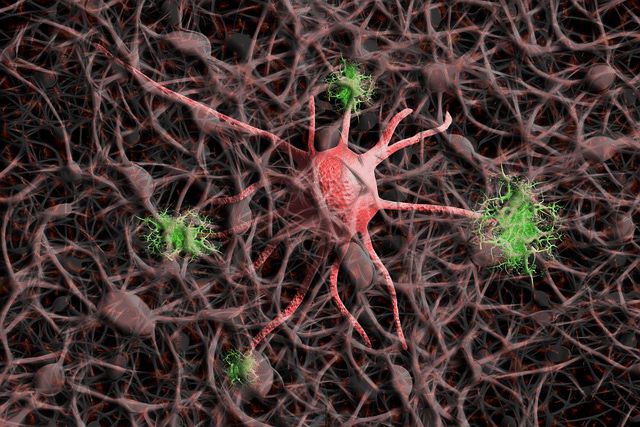“I have, so to speak, lost myself” was the presenting complaint of a 50-year-old woman, Auguste Deter (Maurer et al., 1997). This was the case that was assessed by a psychiatrist – Alois Alzheimer – in 1901 which eventually led to the identification of a neurodegenerative disease that we now know as Alzheimer’s disease (AD). It is one of the most debilitating diseases that is usually associated with aging and is characterised by progressive impairment in recollection of episodic memory which eventually leads to a slow global decline of cognitive functions. Over the last few decades, a lot of focus has been put on the role of the two hallmark proteins of this disease, amyloid-beta (Ab) and tau protein (Vogel et al., 2021). Leading hypotheses in this research field propose the role of these two proteins as causative agents in disease etiology and progression. Recent therapeutic strategies have been devised around the pathophysiology of these proteins, especially tau protein. However, there is a lack of evidence confirming these strategies to be of reliable and undisputed benefits. In the wake of these challenges, researchers have now started to focus on other neurochemical changes in AD. This article will first discuss the most recent findings regarding tau protein and then introduce the importance of a few essential elements (zinc, copper, and iron) in the pathogenesis and treatment of AD.
[read more]
The Braak staging system represents the stereotypical spreading pattern of tau tangles in the brain cortex. It includes six stages which starts from the transentorhinal cortex, spreading through the medial and basal temporal lobes, neocortical associative regions, and finally to unimodal sensory and motor cortical areas. The most common method used to study the progression of tau tangles was through histopathological studies at autopsy. These findings have now been supported by, more recent, in-vivo studies using positron emission tomography (PET). However, it has now been found that some progression differs from the previously represented progression through the Braak staging system. In a very recent article by Vogel et al. (2021), it has been shown that there are at least four different progression patterns for tau protein pathology. The authors proposed these four progression patterns based on spatiotemporal variations as: i. Limbic; ii. Posterior; iii. Lateral temporal; and iv. Medial temporal lobe (MTL) sparing (figure 1). These four patterns further differ based on their clinical characteristics such as APOE4 status, slow/rapid progression, less/more tau, and age of onset. However, even with these discoveries, there is a lack of evidence suggesting tau pathology as the target for reliable and robust therapeutic management.

Figure 1. Representation of the four spatiotemporal progression of tau protein pathology. (Acquired from the article by Vogel et al. (2021))
This lack in reliable therapeutic measures has triggered new directions in research aimed at pathophysiology responsible for AD other than tau protein pathology. It has been found that essential biometals like zinc, copper, and iron have important roles in the pathogenesis of AD (Lei et al., 2021). Zinc has been found to facilitate the formation of amyloid structures from soluble Ab. It has also been found that copper and iron further facilitate Ab aggregation and the formation of ternary complexes (Lei et al., 2021). These are encompassed under ‘The Metal Theory of Alzheimer’s Disease’ by Bush (2013), which argues that depletion of essential metals (zinc, copper, and iron) results in the pathogenesis of AD. This theory also argues that in AD there is an alteration in homeostatic metal regulation due to interaction between the metal transport system and proteins involved in neurodegeneration (Bush, 2013). Recent studies have also found that there is the development of AD in absence of proteopathy but with the presence of dysregulation in homoeostatic metal regulation (Bush, 2013; Lei et al., 2021).
These theories and findings suggest the presence of other therapeutic targets that can be explored. Most of the ongoing clinical trials are focused on proteopathy related to Ab and Tau protein. It is recommended that the clinical trials should start focusing on additional targets such as essential metals and also try to formulate strategies that combine these approaches for better treatment.
References
Bush, A. I. (2013). The metal theory of Alzheimer’s disease. Journal of Alzheimer’s Disease: JAD, 33 Suppl 1, 277. 10.3233/JAD-2012-129011
Lei, P., Ayton, S., & Bush, A. I. (2021). The essential elements of Alzheimer’s disease. Journal of Biological Chemistry, 29610.1074/jbc.REV120.008207
Maurer, K., Volk, S., & Gerbaldo, H. (1997). Auguste D and Alzheimer’s disease. The Lancet, 349(9064), 1546-1549. 10.1016/S0140-6736(96)10203-8
Vogel, J. W., Young, A. L., Oxtoby, N. P., Smith, R., Ossenkoppele, R., Strandberg, O. T., La Joie, R., Aksman, L. M., Grothe, M. J., Iturria-Medina, Y., Pontecorvo, M. J., Devous, M. D., Rabinovici, G. D., Alexander, D. C., Lyoo, C. H., Evans, A. C., & Hansson, O. (2021). Four distinct trajectories of tau deposition identified in Alzheimer’s disease. Nature Medicine, 27(5), 871-881. 10.1038/s41591-021-01309-6 [/read]




Leave a Reply